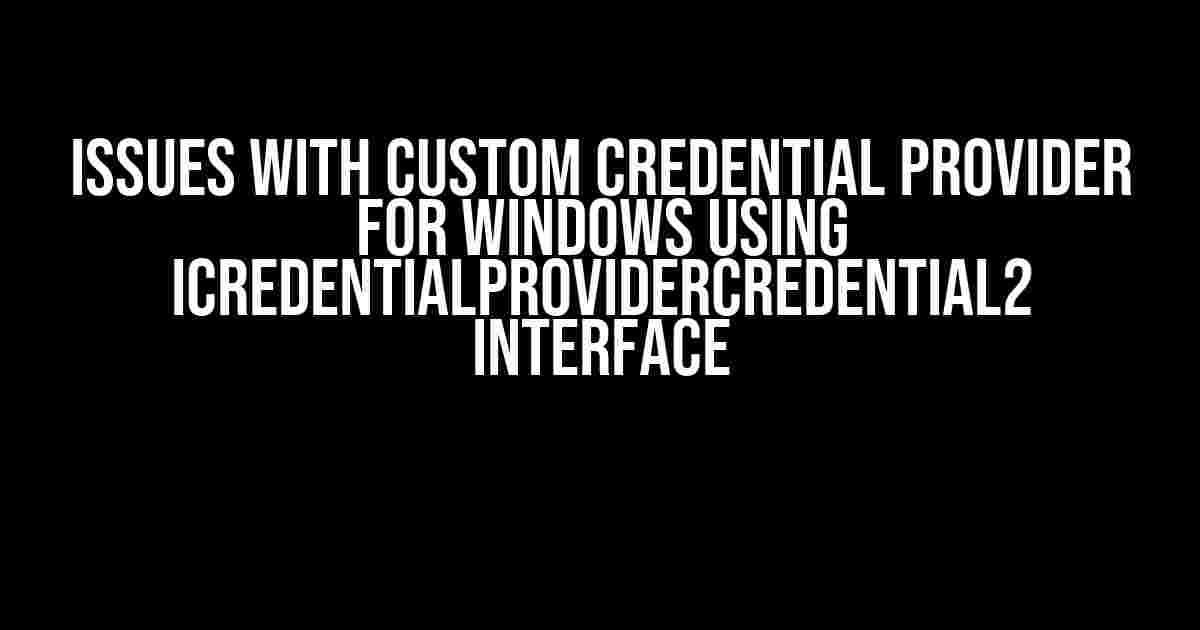Are you tired of dealing with the headaches of creating a custom credential provider for Windows using the ICredentialProviderCredential2 interface? You’re not alone! Many developers have struggled with this complex and nuanced topic. In this article, we’ll dive deep into the common issues you may encounter and provide clear, step-by-step solutions to get you back on track.
The ICredentialProviderCredential2 Interface: A Brief Overview
The ICredentialProviderCredential2 interface is a crucial component of the Windows Credential Provider framework, allowing developers to create custom credential providers that integrate seamlessly with the Windows login experience. However, its complexity can lead to a multitude of issues, which we’ll explore in this article.
Issue 1: Incorrectly Implemented ICredentialProviderCredential2 Interface
One of the most common issues developers face is failing to correctly implement the ICredentialProviderCredential2 interface. This can result in the custom credential provider not being recognized by Windows or behaving erratically.
// Example of incorrect implementation
class CustomCredentialProvider : ICredentialProviderCredential2
{
// Missing or incomplete implementation of interface methods
}
To avoid this issue, ensure that you’ve correctly implemented all the required methods of the ICredentialProviderCredential2 interface, including:
- GetSerialization()
- GetComboBoxPairwiseInfo()
- GetFieldDescriptors()
- GetCredentialCount()
- GetCredentialAt()
- GetCredentialType()
Issue 2: Incorrect Use of COM Interop
COM Interop is a fundamental aspect of the Windows Credential Provider framework, but incorrect usage can lead to issues with the custom credential provider.
// Example of incorrect COM Interop usage
[ComVisible(true)]
[ClassInterface(ClassInterfaceType.AutoDispatch)]
public class CustomCredentialProvider : ICredentialProviderCredential2
{
// Incorrect marshaling of COM objects
}
To avoid this issue, ensure that you’ve correctly registered the COM component and marshaled the COM objects correctly. Use the following steps:
- Register the COM component using the regasm tool.
- Use the
[ComVisible(true)]attribute to make the COM component visible. - Use the
[ClassInterface(ClassInterfaceType.AutoDispatch)]attribute to specify the COM interface type.
Issue 3: Credential Provider not Displaying Correctly
Sometimes, the custom credential provider may not display correctly in the Windows login screen or other credential prompt scenarios. This can be due to issues with the credential provider’s UI or incorrect implementation of the ICredentialProviderCredential2 interface.
| Credential Provider UI Issue | Solution |
|---|---|
| Credential provider not displaying at all | Check that the credential provider is correctly registered and that the ICredentialProviderCredential2 interface is implemented correctly. |
| Credential provider displaying incorrectly | Verify that the credential provider’s UI is correctly implemented and that the GetFieldDescriptors() method returns the correct field descriptors. |
Issue 4: Credential Provider Not Authenticating Correctly
If the custom credential provider is not authenticating correctly, it may be due to issues with the credential validation or incorrect implementation of the ICredentialProviderCredential2 interface.
// Example of incorrect credential validation
bool IsValidCredential(string username, string password)
{
// Incorrect credential validation logic
return false;
}
To avoid this issue, ensure that you’ve correctly implemented the credential validation logic and that the GetCredentialType() method returns the correct credential type.
Issue 5: Debugging the Custom Credential Provider
Debugging a custom credential provider can be challenging due to the complex nature of the Windows Credential Provider framework.
// Example of attaching a debugger to the custom credential provider
System.Diagnostics.Debugger.Launch();
To debug the custom credential provider, use the following steps:
- Attach a debugger to the custom credential provider process.
- Use breakpoints to step through the code and identify the issue.
- Verify that the custom credential provider is correctly registered and that the ICredentialProviderCredential2 interface is implemented correctly.
Conclusion
In conclusion, creating a custom credential provider for Windows using the ICredentialProviderCredential2 interface can be a complex and challenging task. However, by following the solutions outlined in this article, you can overcome the common issues and create a seamless and secure credential provider experience for your users.
Remember to correctly implement the ICredentialProviderCredential2 interface, use COM Interop correctly, ensure the credential provider displays correctly, authenticate correctly, and debug the custom credential provider effectively. With these tips, you’ll be well on your way to creating a custom credential provider that meets your organization’s unique needs.
Still having issues? Check out our comprehensive guide to Windows Credential Providers for more in-depth information and troubleshooting tips.
Frequently Asked Questions
Get answers to the most common issues with custom credential provider for Windows using ICredentialProviderCredential2 interface.
Why is my custom credential provider not displaying in the Windows login screen?
This could be due to incorrect registration of your custom credential provider. Make sure to register your provider under the correct registry key (HKEY_LOCAL_MACHINE\SOFTWARE\Microsoft\Windows\CurrentVersion\Authentication\Credential Providers) and specify the correct CLSID. Also, ensure that your provider implements the required interfaces, including ICredentialProviderCredential2.
How do I handle errors in my custom credential provider implementation?
To handle errors, implement the IErrorResult interface in your custom credential provider. This allows you to return an error message to the user when an error occurs. Additionally, log errors using the Windows Event Log or a custom logging mechanism to facilitate debugging.
Can I use a single instance of my custom credential provider for multiple users?
No, each user session requires a separate instance of your custom credential provider. This is because Windows creates a new instance of the credential provider for each user login. To accommodate this, design your provider to be singleton-free and ensure that each instance is thread-safe.
Why is my custom credential provider not receiving credential updates?
This could be due to incorrect implementation of the ICredentialProviderCredential2 interface. Ensure that you’re implementing the SetSelected method correctly, as it’s responsible for updating the credential status. Also, verify that your provider is registered to receive notifications using the ICredentialProviderEvents interface.
How do I optimize the performance of my custom credential provider?
To optimize performance, minimize the usage of expensive operations like database queries or network calls. Implement caching or local storage to reduce the load on your provider. Additionally, ensure that your provider is implemented using multi-threading to handle concurrent requests efficiently.



